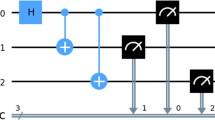Abstract
Unconditionally secure two-party bit commitment based solely on the principles of quantum mechanics (without exploiting special relativistic signalling constraints, or principles of general relativity or thermodynamics) has been shown to be impossible, but the claim is repeatedly challenged. The quantum bit commitment theorem is reviewed here and the central conceptual point, that an “Einstein–Podolsky–Rosen” attack or cheating strategy can always be applied, is clarified. The question of whether following such a cheating strategy can ever be disadvantageous to the cheater is considered and answered in the negative. There is, indeed, no loophole in the theorem.
Similar content being viewed by others
REFERENCES
Y. Aharonov, P. G. Bergmann, and J. L. Lebowitz, “Time symmetry in the quantum process of measurement,” Rev. B 134, 1410–1416 (1964).
D. Ahoronov, A. Ta-Shma, U. V. Vazirani, and A. C. Yao, “Quantum bit escrow,” Los Alamos Preprint archive quant-ph/0004017.
M. Ardehali, “A perfectly secure quantum bit commitment protocol,” Los Alamos Preprint archive quant-ph/9505019.
J. S. Bell, “On the Einstein-Podolsky-Rosen paradox,” Physics 1, 195–200 (1987).
C. H. Bennett and G. Brassard, “Quantum cryptography: Public key distribution and coin tossing,” in Proceedings of IEEE International Conference on Computers, Systems, and Signal Processing, IEEE (1984), pp. 175–179.
G. Brassard and C. Crépeau, “Quantum bit commitment and coin-tossing protocols,” in Advances in Cryptology: Proceedings of Crypto '90 (Lecture Notes in Computer Science, Vol. 537) (Springer, New York, 1991), pp. 49–61.
G. Brassard, C. Crépeau, R. Jozsa, and D. Langlois, “A quantum bit commitment scheme-provably unbreakable by both parties,” in Proceedings of the 34th Annual IEEE Sym-posium and the Foundations of Computer Science (Nov. 1993), pp. 362–371.
G. Brassard, C. Crépeau, D. Mayers, and L. Salvail, “A brief review on the impossibility of quantum bit commitment,” Los Alamos Preprint archive quant-ph/97120203.
G. Brassard, C. Crépeau, and D. Mayers, “Defeating classical bit commitments with a quantum computer,” Los Alamos Preprint archive quant-ph/9806031.
G. Brassard, C. Crépeau, D. Mayers, and L. Salvail, “The security of quantum bit commit-ment schemes,” in Proceedings of Randomized Algorithms, Satellite Workshop of 23rd International Symposium on Mathematical Foundations of Computer Science, Brno, Czech Republic, August 1998, pp. 13–15.
C.-Y. Cheung, “On the possibility of unconditionally secure quantum bit commitment,” Los Alamos Preprint archive quant-ph/9909048.
C. A. Fuchs and K. Jacobs, “Information tradeoff Relations for finite-strength quantum measurements,” Los Alamos Preprint archive quant-ph/0009101.
L. Goldenberg, L. Vaidman, and S. Wiesner, “Quantum gambling,” Phys. Rev. Lett. 82, 3356–3359 (1999).
L. Hardy and A. Kent, “Cheat sensitive quantum bit commitment,” Los Alamos Preprint archive quint-ph/9911043.
L. P. Hughston, R. Jozsa, and W. K. Wootters, “A complete classification of quantum ensembles having a given density matrix,” Phys. Lett. A 183, 14–18 (1993).
A. Kent, “Unconditionally secure bit commitment,” Phys. Rev. Lett. 83, 1447–1450 (1999).
A. Kent, “Secure classical bit commitment over finite channels,” Los Alamos Preprint archive quant-ph/9906103.
A. Kent, “Unconditionally secure commitment of a certified classical bit is impossible,” Phys. Rev. A 61, 042301 (2000).
H.-K. Lo and H. F. Chau, “Is quantum bit commitment really possible?,” Phys. Rev. Lett. 78, 3410–3413 (1997); original version: Los Alamos Preprint archive quant-ph-9603004.
H.-K. Lo and H. F. Chau, “Why quantum bit commitment and ideal coin tossing are impossible,” in Proceedings of the Fourth Workshop on Physics and Computation (Boston: New England Complex System Institute, 1996), p. 76. Los Alamos Preprint archive quant-ph/9605026; revised version in Physica D 120, 177–187 (1998).
H.-K. Lo and H. F. Chau, “Making an empty promise with a quantum computer,” Fortschr. Phys. 46, 507–519 (1998).
H.-K. Lo, “Insecurity of quantum secure computations,” Phys. Rev. A 56, 1154 (1997).
H.-K. Lo, “Quantum cryptology,” in Introduction to Quantum Computation and Information, K. K. Lo, S. Popescu, and T. Spiller, eds. (World Scientific, Singapore, 1998).
D. Mayers, presentation at the 4th Montreal Workshop on Quantum Information Theory (October 1995).
D. Mayers, “The trouble with quantum bit commitment,” Los Alamos Preprint archive quant-ph/9603015.
D. Mayers, “Unconditionally secure quantum bit commitment is impossible,” in Proceedings of the Fourth Workshop on Physics and Computation (New England Complex System Institute, Boston, 1996), pp. 224–228.
D. Mayers, “Unconditionally secure quantum bit commitment is impossible,” Phys. Rev. Lett. 78, 3414–3417 (1997).
A. Mitra, “Unconditionally secure quantum bit commitment is simply possible,” Los Alamos Preprint archive phys/0007089.
S. N. Molotkov and S. S. Nazin, “Unconditionally secure relativistic quantum bit commitment,” Los Alamos Preprint archive quant-ph/9901055.
L. Vaidman, Y. Aharonov, and D. Z. Albert, “How to ascertain the values of σx, σy, and σz, of a spin-1/2 particle,” Phys. Rev. Lett. 58, 1385–1387 (1987).
H. P. Yuen, “Unconditionally secure quantum bit commitment is possible,” Los Alamos Preprint archive quant-ph/0006109.
Author information
Authors and Affiliations
Rights and permissions
About this article
Cite this article
Bub, J. The Quantum Bit Commitment Theorem. Foundations of Physics 31, 735–756 (2001). https://doi.org/10.1023/A:1017597528026
Issue Date:
DOI: https://doi.org/10.1023/A:1017597528026




